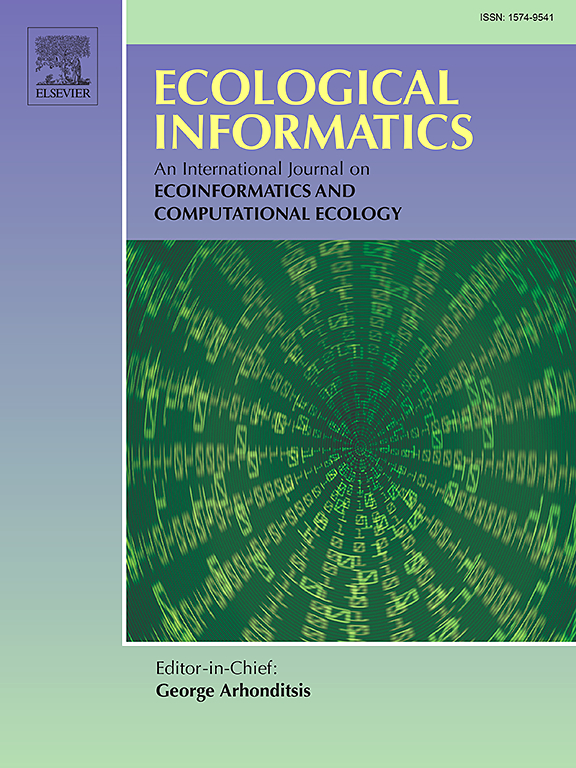IF 5.8
2区 环境科学与生态学
Q1 ECOLOGY
引用次数: 0
摘要
生态系统核算是将自然纳入可持续决策的一种结构化方式。联合国通过了环境经济核算体系-生态系统核算(SEEA-EA),作为收集生境数据和编制生态系统账户的一套国际标准。生态系统范围账户是 SEEA-EA 框架的四大支柱之一,其中生态系统核算区域的空间组成按生境类型分组,并对土地覆被随时间的变化进行量化。虽然有多种工具可用于编制范围账户,但其中大多数都需要中等至高等级的专业技术知识。在此,我们介绍 ExActR(R 中的范围账户),这是一个开源应用程序,用于使用 shapefiles(一种地理空间矢量数据格式)生成范围账户。该应用程序由 R 和相关的 Shiny 框架构建,当用户与之交互时会自动更新。该应用程序支持多个时间点,可为连续的时间点对生成范围账户(表格),以满足用户跨多个时期进行动态生态系统评估的需求。数据可视化的形式包括每个时间点的互动(传单)和静态地图,以及说明土地类型组成和变化的柱状图。该应用程序的一个版本已经部署(可在 https://gibbona1.shinyapps.io/extent_app/ 上获取),为生态系统的互动探索提供了空间。Shiny 的反应性与 JavaScript 插件相结合,可将表格复制成多种格式,包括 LaTeX 和绘图,使应用程序的结果适合直接插入报告中。该应用程序适用于任何空间分组变量。我们在 CORINE 土地覆被数据的小型和大型研究地点上测试了其功能,并在爱尔兰一个风电场施工期间和施工后使用超高分辨率卫星图像生成了土地覆被图,证明了其适应各种土地覆被分类系统的能力。该工具可用于了解、可视化和跟踪生态系统资产的变化,帮助科学家和利益相关者进行解释。本文章由计算机程序翻译,如有差异,请以英文原文为准。
ExActR: A Shiny app for creating ecosystem extent accounts
Ecosystem accounting is a structured way to integrate nature into sustainable decision-making. The System of Environmental Economic Accounting-Ecosystem Accounting (SEEA-EA) was adopted by the United Nations as a set of international standards for the collection of habitat data and compiling ecosystem accounts. The ecosystem extent account is one of the four pillars of the SEEA-EA framework, where the spatial composition of an ecosystem accounting area is grouped by habitat types, and the land cover change over time is quantified. Although a variety of tools exist for preparing extent accounts, most of them require moderate to high levels of technical expertise. Here, we present ExActR (Extent Accounts in R), an open-source application for generating extent accounts using shapefiles, a geospatial vector data format. The app is built in R and the associated Shiny framework, which automatically updates as the user interacts with it. The application supports multiple timepoints, where extent accounts (tables) are generated for consecutive pairs of timepoints, accommodating users’ needs for dynamic ecosystem assessments across several periods. Data visualisations are generated in the form of both interactive (leaflet) and static maps of each timepoint, and barplots to illustrate land type composition and change. A version of the app has been deployed (available at https://gibbona1.shinyapps.io/extent_app/), offering a space for interactive exploration of ecosystems. Shiny’s reactivity, combined with JavaScript plugins for copying tables into multiple formats, including LaTeX and plots, make the application results suitable to insert directly into reports. The app is suitable for using with any spatial grouping variable. We test its functionality on small and large study sites on CORINE land cover data, as well as land cover maps generated using very-high resolution satellite imagery of a wind farm site in Ireland, during and post construction, demonstrating its ability to adapt to various land cover classification systems. The tool can be used to understand, visualise and track changes in ecosystem assets, aiding interpretation by both scientists and stakeholders.
求助全文
通过发布文献求助,成功后即可免费获取论文全文。
去求助
来源期刊

Ecological Informatics
环境科学-生态学
CiteScore
8.30
自引率
11.80%
发文量
346
审稿时长
46 days
期刊介绍:
The journal Ecological Informatics is devoted to the publication of high quality, peer-reviewed articles on all aspects of computational ecology, data science and biogeography. The scope of the journal takes into account the data-intensive nature of ecology, the growing capacity of information technology to access, harness and leverage complex data as well as the critical need for informing sustainable management in view of global environmental and climate change.
The nature of the journal is interdisciplinary at the crossover between ecology and informatics. It focuses on novel concepts and techniques for image- and genome-based monitoring and interpretation, sensor- and multimedia-based data acquisition, internet-based data archiving and sharing, data assimilation, modelling and prediction of ecological data.
 求助内容:
求助内容: 应助结果提醒方式:
应助结果提醒方式:


